Tourmaline, a mesmerizing gemstone celebrated for its kaleidoscopic hues, has captivated humanity for centuries. Beyond its sheer beauty, each color variation of tourmaline is believed to possess unique metaphysical properties and symbolic meanings. From the fiery reds to the tranquil blues, the spectrum of tourmaline offers a rich tapestry of significance. In this comprehensive exploration, we delve into the profound meanings behind the diverse colors of tourmaline, shedding light on their cultural, spiritual, and historical significance.
The Origins of Tourmaline
Before delving into the meanings of tourmaline’s colors, it’s crucial to understand the gemstone’s origins and composition. Tourmaline is a complex boron silicate mineral with a unique crystal structure that accounts for its vibrant range of colors. Formed in diverse geological environments, tourmaline can be found in various parts of the world, including Brazil, Afghanistan, Nigeria, and the United States.
One of the most fascinating aspects of tourmaline is its pleochroism, a phenomenon where the gemstone exhibits different colors when viewed from different angles. This inherent property adds to the allure and mystique of tourmaline, making it a favorite among gemstone enthusiasts and collectors worldwide.
Cultural and Historical Significance
Throughout history, tourmaline has held a special place in various cultures and civilizations, revered for its beauty and metaphysical properties. In ancient Egypt, tourmaline was cherished as a talisman of protection, believed to ward off negative energies and evil spirits. Similarly, in ancient China, tourmaline was prized for its ability to harmonize yin and yang energies, promoting balance and harmony.
During the Renaissance period, tourmaline experienced a resurgence in popularity among European aristocracy, who valued the gemstone for its rarity and vibrancy. It adorned royal jewelry and ceremonial regalia, symbolizing wealth, status, and sophistication.
In contemporary times, tourmaline continues to captivate jewelry designers and spiritual seekers alike, serving as a source of inspiration and empowerment. Its versatile colors and metaphysical properties make it a beloved choice for gemstone enthusiasts seeking both aesthetic beauty and spiritual resonance.
Meanings of Tourmaline’s Hues
Each color of tourmaline is believed to resonate with distinct energies, carrying symbolic meanings that have been cherished across cultures and civilizations. Let’s embark on a journey through the color spectrum of tourmaline, unraveling the significance behind each shade:
Red Tourmaline (Rubellite): Symbolizing passion, vitality, and courage, red tourmaline, also known as rubellite, is associated with the fire element. It is believed to ignite the life force within, inspiring action and creativity. In metaphysical practices, red tourmaline is often used to stimulate the root chakra, promoting a sense of grounding and stability.
Pink Tourmaline: Radiating gentle, nurturing energies, pink tourmaline embodies love, compassion, and emotional healing. It is regarded as a stone of the heart, fostering empathy and fostering deep connections with oneself and others. Pink tourmaline is often used in meditation and energy work to open the heart chakra, facilitating inner harmony and self-acceptance.
Green Tourmaline: With its verdant hues reminiscent of lush forests, green tourmaline symbolizes growth, abundance, and renewal. It is associated with the earth element, grounding energy and promoting physical vitality. Green tourmaline is believed to align with the heart chakra, encouraging balance and harmony in all aspects of life.
Blue Tourmaline (Indicolite): Reflecting the serene depths of the ocean, blue tourmaline, also known as indicolite, evokes feelings of tranquility, clarity, and intuition. It is associated with the water element, cleansing the mind and soothing the spirit. Blue tourmaline is often used in meditation to enhance psychic abilities and promote inner wisdom.
Multicolored Tourmaline (Watermelon Tourmaline): Aptly named for its resemblance to the juicy fruit, watermelon tourmaline combines pink and green hues in a captivating fusion. This unique gemstone is believed to harmonize the energies of the heart and root chakras, fostering balance and alignment. Watermelon tourmaline is cherished for its ability to promote emotional healing and spiritual growth.
Black Tourmaline: Revered for its protective properties, black tourmaline serves as a shield against negative energies and psychic attacks. It is associated with the root chakra, grounding energy and promoting a sense of security and empowerment. Black tourmaline is often used in crystal healing practices to create energetic boundaries and dispel negativity.
Yellow Tourmaline: Symbolizing joy, optimism, and abundance, yellow tourmaline radiates sunny energy that uplifts the spirit. It is associated with the solar plexus chakra, enhancing self-confidence and personal power. Yellow tourmaline is believed to attract prosperity and success, stimulating creativity and manifesting abundance in all areas of life.
Conclusion
In conclusion, the diverse colors of tourmaline offer a window into a world of symbolism, spirituality, and cultural significance. From the fiery reds to the tranquil blues, each hue carries its own unique energy and meaning, inviting us to explore the depths of our inner selves and connect with the rhythms of the natural world.
Whether worn as jewelry, used in meditation, or simply admired for its exquisite beauty, tourmaline continues to enchant and inspire generations of individuals across the globe. As we embrace the spectrum of tourmaline, may we be reminded of the profound interconnectedness of all things and the enduring power of the human spirit to seek beauty, meaning, and transcendence in the world around us.


